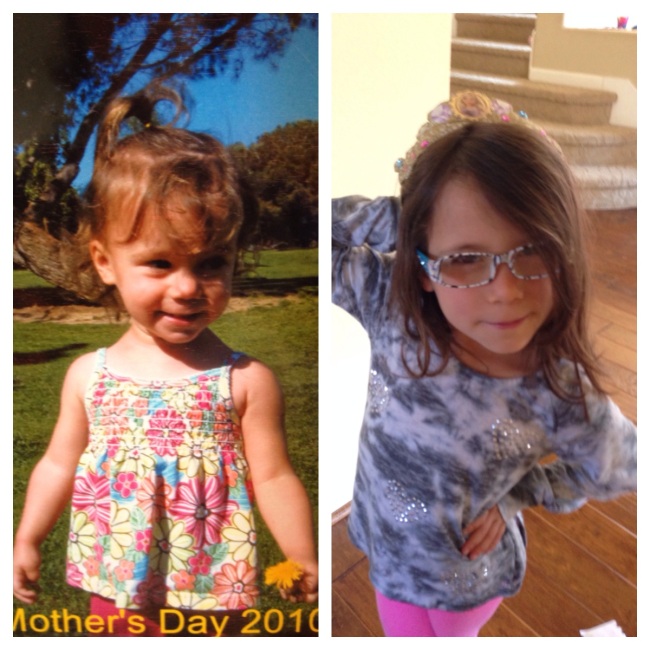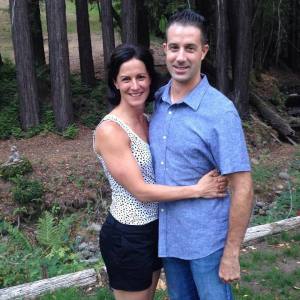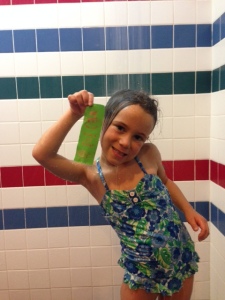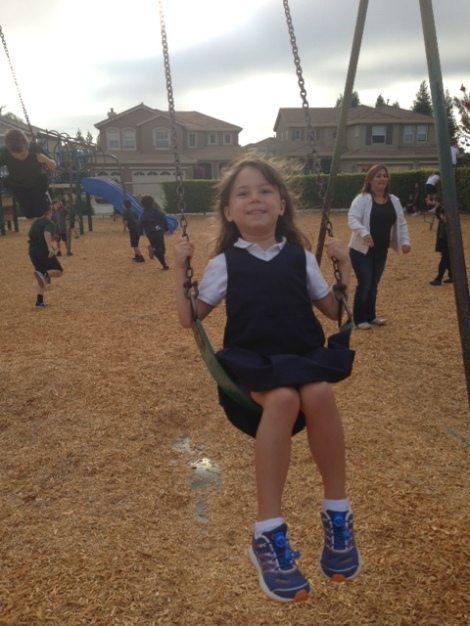
I don’t know if you can see the transformation that I see in these photos. It’s been nearly 4 years since the photo on the left was taken. It was given to me by our day care provider, Michelle, whom I am positive spent many attempts to get Charlotte to look at the camera and smile at the same time. This was the best it was going to get. Her body is rigid. Her eyes are not working together to focus straight ahead, and she is sweaty and hot from running and playing hard to regulate herself at the park that day. While it may seem innocent and very typical, for me, it is a visual reminder of how far we’ve come.
This month, April, marks 4 years on our Paleo journey. Charlotte walked into the kitchen a few weeks ago wearing some silly glasses, a cute top, hot pink pants, and a princess crown. I asked her to stand still so I could snap a photo. The photo on the right is what I got. Eyes locked on the camera. Body relaxed. Sassy, expressive, and just so Charlotte. And so different from where we were.
In four years time, Charlotte was re-born. A healthy body and mind that makes us laugh and shake our heads in wonder every single day. A true transformation that is difficult to express in Before and After photographs.
As I reflect on the last four years, it’s not just Charlotte’s transformation that has me blissfully stunned and dismayed. It’s my own. It’s also how we’ve all changed as a family. It’s amazing to me that something so tragic and dark as an Autism diagnosis has brought a gift of light and hope and gratitude that fills my heart every day.
For a while we controlled everything about Charlotte’s life…from her food to her clothing to anything that would upset the delicate balance and send her into a spiral of anxiety and dysregulation. While it may not seem like it on the outside, we’re changing. We try to be less rigid ourselves, to go with the flow and observe her behavior, interactions, and a budding independence.
This week I bought the girls the soundtrack to the movie Frozen to listen to in the car. As I drove to school to pick them up, I thought about the bickering that would come over who would sing. Dana wanting to sing her heart out and Charlotte screaming in a loss of control and sensory overload. I began to rehearse my script for how there would need to be rules and lots of turn taking, how to deal with the pouting and competition over the volume, song choice, and who could sing the loudest. And then I stopped myself. I trusted the work we’ve done and let them work it out themselves. This is a big deal when you are a control freak like me, particularly in a confined space of my mini van. But it worked beautifully. They worked together, choosing their favorites to sing and sharing nicely.
We’re changing and growing. We’re learning and supporting each other. We’re allowing the sassy-ness, bossiness, and expression to all come out to play. We’re dealing with issues as they come up and generally feeling a bit less stress. We’re hanging tough and through this process, becoming more accepting and tolerant.
I notice this difference in myself when I talk to other moms about diet change. I’ve become much more tolerant and accepting of what others are doing to feed their families. I’ve become much better at listening to what others are dealing with. It’s been very humbling as I clearly don’t have all of the answers. And when you throw a husband, other children, and three meals a day into the mix, it certainly creates a challenge that is bigger than me.
But that being said, I still feel the need to help those who are ready to make a change with food and their kids. I’ve compiled a list of things I think you need to know as you begin, continue, or adapt in your Paleo journey. If I’ve learned anything on this journey, it’s that everybody needs something different. Some need a push to get them going, a little guilt or fear sparks an interest and a change begins. Others need more time and space to think and talk about how this is all going to work. I can’t help those who can’t get past the thought of life without bread. You’ll notice a little good cop, bad cop as I’m hoping it strikes a spark in everyone wanting to make a change.
1. Social Situations are hard at first.
Birthday parties or other social events around food or eating are challenging. There’s no getting around it. The best way I’ve learned to handle this is to plan ahead whenever possible. Typically, I feed the kids before we attend a social event where I’m not certain what is being served. With a full belly, they’re less interested in eating pizza and more interested in playing and enjoying the party. It helps to communicate with the host of the party before hand to let them know you may bring an alternative meal or treat or just pass on food all together. This may seem strange at first, but it gets much easier with practice. If we are going out to eat, we discuss some ground rules before entering the restaurant. We tend to do hash browns with ketchup instead of pancakes, french fries instead of a bun, and always water to drink, never soda. The key here is confidence and some will power. If you set the example as the person making good choices and thinking ahead, others in your family will follow.
2. Paleo is Personal.
in my opinion, there are no set rules for Paleo, only guidelines. The idea is to eat cleaner than you did before you started. The foods that are restricted in Paleo are processed or sugary foods that tend to aggravate symptoms of stomach discomfort, hyperactivity, inflammation, weight gain, or other issues in the body. Certain foods may not be an issue for you or your kids. The best way to find out how strict you need to be is to cut out foods one at a time (or a few at once) and see how the body responds. If you add them back in and a have negative result, that food is not best for you (or child) right now. This doesn’t mean it’s Paleo to eat donuts or cereal because it doesn’t upset your stomach. It’s about listening to your body and adding back in foods like dairy or carbs to see what your body can handle. What’s different for you is different for me. And while it may seem to be easier for me or someones else, it’s really not. We all have temptations with food and different ways of dealing with it. So, it’s really up to you…baby steps versus cold turkey…you won’t know until you try.
3. Parenting and Food.
Chad and I learned early on in our marriage that we have different ways of expressing love and affection to each other. Learning to speak each other’s Love Languages has been a huge learning experience for us, but one that has benefited us tremendously. One thing I’ve noticed is that many parents express love and affection with their children through food. This is neither good nor bad. We are human beings and feeding our children is instinctual. For some, treats and special meals are ways of showing how much we care. Sometimes the more the child loves the food, the more the parent feels fulfilled and a unique love language is born. I find that it is more difficult for parents who speak this “food love language” to make the lifestyle change that Paleo requires. Making changes around food and kids involves making changes around parenting. It is hard but not impossible. We are human beings, and we can change the way we love. We can accept new challenges and change our parenting as a result, if that’s what we want to do.
4. No excuses.
I went to Costco a few days ago and was overwhelmed. There were more Paleo options than ever and I had resist the urge to put items in my cart that were “Paleo”, even though I really had no need for them. From Kombucha to Kerrygold cheese to Chia seeds, there is an abundance of real food at our fingertips. It has not always been this way. Just a few years ago, I had to order my coconut flour online if I wanted to do any baking. Now I can pick it up at Nob Hill with my eggs and produce. It is easier than ever to eat Paleo. More people have heard of it, and it reduces the amount of stress or anxiety you or your children may feel around eating differently. Four years ago when we began eating this way, there were only a handful of websites and 1 or 2 cookbooks. Now there are more than I can keep track of. Our gym actually has frozen Paleo meals delivered to those who ordered ahead. Times, they are a changin’, and it’s for the better.
5. Let it Go.
It’s only been a few days since the Frozen cd debuted in my car, but I’ve already heard this song more times than I can count. I laugh out loud at the girls belting it out from the back seats, but can’t help but love the message it sends. I am making a conscious effort to Let Go of unhealthy thoughts and perfection. I ignore posts on my Facebook feed about healthy cleaning products and the dangers of conventional meat and produce (gasp!). I only recently started reading about essential oils because it was all just too much. I have found what works, and I don’t try to do everything. There is no Paleo Perfection. If you screw up and eat bad, get back on track. If you have a few non-Paleo favorite treats that make you feel like a normal person, rock on. Just keep your thoughts healthy and your food clean as much as you can. It’s your body. They’re your kids, and the only expectations you have are the ones you put on yourself. Find what works and stick to it. I am so glad that we did, and I am looking forward to seeing the growth in our family over the next four years.






















